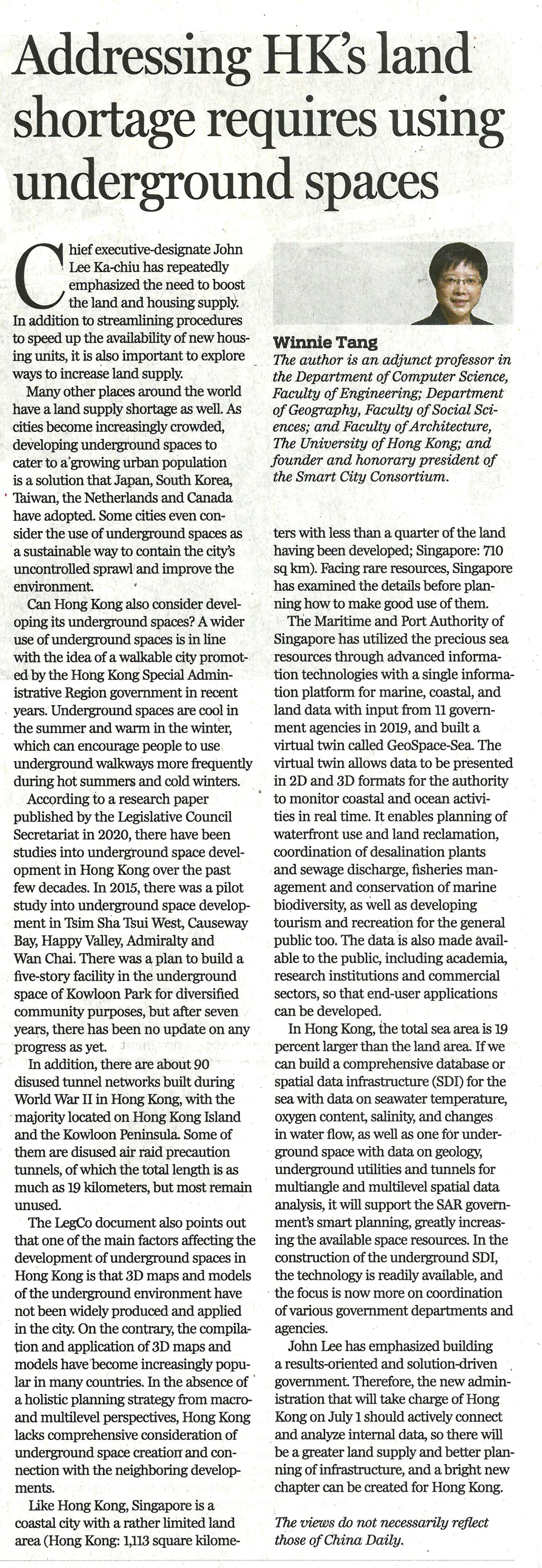網上版請按此

Addressing HK's land shortage requires using underground spaces
Chief executive-designate John Lee Ka-chiu has repeatedly emphasized the need to boost the land and housing supply. In addition to streamlining procedures to speed up the availability of new housing units, it is also important to explore ways to increase land supply.
Many other places around the world have a land supply shortage as well. As cities become increasingly crowded, developing underground spaces to cater to a growing urban population is a solution that Japan, South Korea, Taiwan, the Netherlands and Canada have adopted. Some cities even consider the use of underground spaces as a sustainable way to contain the city's uncontrolled sprawl and improve the environment.
Can Hong Kong also consider developing its underground spaces? A wider use of underground spaces is in line with the idea of a walkable city promoted by the Hong Kong Special Administrative Region government in recent years. Underground spaces are cool in the summer and warm in the winter, which can encourage people to use underground walkways more frequently during hot summers and cold winters.
According to a research paper published by the Legislative Council Secretariat in 2020, there have been studies into underground space development in Hong Kong over the past few decades. In 2015, there was a pilot study into underground space development in Tsim Sha Tsui West, Causeway Bay, Happy Valley, Admiralty and Wan Chai. There was a plan to build a five-story facility in the underground space of Kowloon Park for diversified community purposes, but after seven years, there has been no update on any progress as yet.
In addition, there are about 90 disused tunnel networks built during World War II in Hong Kong, with the majority located on Hong Kong Island and the Kowloon Peninsula. Some of them are disused air raid precaution tunnels, of which the total length is as much as 19 kilometers, but most remain unused.
The LegCo document also points out that one of the main factors affecting the development of underground spaces in Hong Kong is that 3D maps and models of the underground environment have not been widely produced and applied in the city. On the contrary, the compilation and application of 3D maps and models have become increasingly popular in many countries. In the absence of a holistic planning strategy from macro- and multilevel perspectives, Hong Kong lacks comprehensive consideration of underground space creation and connection with the neighboring developments.
Like Hong Kong, Singapore is a coastal city with a rather limited land area (Hong Kong: 1,113 square kilometers with less than a quarter of the land having been developed; Singapore: 710 sq km). Facing rare resources, Singapore has examined the details before planning how to make good use of them.
The Maritime and Port Authority of Singapore has utilized the precious sea resources through advanced information technologies with a single information platform for marine, coastal, and land data with input from 11 government agencies in 2019, and built a virtual twin called Geo-Space-Sea. The virtual twin allows data to be presented in 2D and 3D formats for the authority to monitor coastal and ocean activities in real time. It enables planning of waterfront use and land reclamation, coordination of desalination plants and sewage discharge, fisheries management and conservation of marine biodiversity, as well as developing tourism and recreation for the general public too. The data is also made available to the public, including academia, research institutions and commercial sectors, so that end-user applications can be developed.
In Hong Kong, the total sea area is 19 percent larger than the land area. If we can build a comprehensive database or spatial data infrastructure (SDI) for the sea with data on seawater temperature, oxygen content, salinity, and changes in water flow, as well as one for underground space with data on geology, underground utilities and tunnels for multiangle and multilevel spatial data analysis, it will support the SAR government's smart planning, greatly increasing the available space resources. In the construction of the underground SDI, the technology is readily available, and the focus is now more on coordination of various government departments and agencies.
John Lee has emphasized building a results-oriented and solution-driven government. Therefore, the new administration that will take charge of Hong Kong on July 1 should actively connect and analyze internal data, so there will be a greater land supply and better planning of infrastructure, and a bright new chapter can be created for Hong Kong.
Dr. Winnie Tang
Adjunct Professor, Department of Computer Science, Faculty of Engineering; Department of Geography, Faculty of Social Sciences; and Faculty of Architecture, The University of Hong Kong